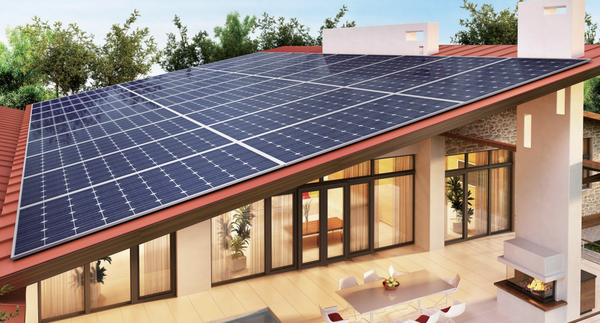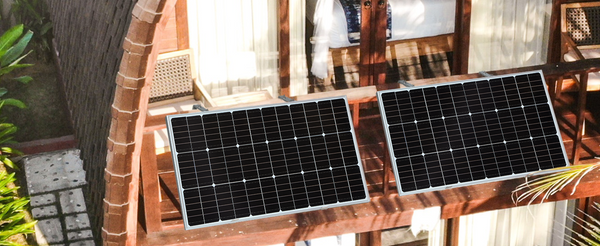
Planning a Home Solar Electric System
There are a number of steps to follow when planning to power your home with solar energy. After choosing which option is best for you to use solar (see step 3), follow the steps afterward that apply to you. Your solar energy installer and local utility company can provide more information on the exact steps you will need to take to power your home with solar energy.
- Investigate your home's energy efficiency
- Assess your solar potential and any limitations
- Assess your options for going solar
- Estimate your solar electricity needs
- Obtain bids and site assessments from contractors
- Understand available financing and incentives
- Work with your installer and utility to install the system and set up agreements
1. Investigate Your Home's Energy Efficiency
Before starting the process of powering your home with solar energy, homeowners should investigate their energy use and consider potential efficiency upgrades. Homeowners should be well aware of their total electricity usage, and consider low-cost and easy-to-implement efficiency measures before choosing solar.
Explore the following resources to reduce your electricity use:
- Home energy audits:A home energy audit can help you understand where your home is losing energy and what steps to take to improve the efficiency of your home.
- Appliances and electronics:Use your appliances and electronics more efficiently, or consider investing in highly efficient products.
- Lighting:Switch to energy efficient lighting, such as LED light bulbs.
- Heating and cooling:If you use electricity to heat and cool your home, your heating and cooling needs will significantly affect the amount of solar energy you need. Weatherizing your home and heating and cooling efficiently will reduce the amount of electricity you need to produce with solar.
2. Assess Your Solar Potential
Before deciding on the best way to use solar electricity at home, assess the potential solar energy that can be produced at your address. Because PV technologies use both direct and scattered sunlight to create electricity, the solar resource across the United States is ample for home solar electric systems.
However, the amount of power generated by a solar energy system at a particular site depends on how much of the sun's energy reaches it, and the size of the system itself.
Several mapping services and tools are available to help you determine your home’s solar energy potential. Some of the services also offer information on the estimated system size, potential costs and savings, and local contractors.
These tools are an excellent starting point and can help you determine whether your home is suitable for solar, and if not, the best path forward for still benefiting from solar. While these tools are helpful, they don't account for all of the variables that need to be considered for your particular system. For that, you will need to work directly with a solar installer who can provide an accurate assessment of your solar potential as well as detailed recommendations, estimates, and equipment expertise.
Consider the following:
- Nearby shade trees. Contractors will also help evaluate shading, but also consider your own or your neighbor's trees that are still growing and could shade your system in the future.
- The age of your roof and how long until it will need to be replaced. If you expect to need a new roof within the next few years, you may want to consider making that improvement before installing solar.
- Neighborhood or homeowner association (HOA) restrictions or approval requirements. Some states now have "solar rights provisions" limiting the ability of HOAs to restrict solar installations or limit solar access. These provisions vary state to state, and by municipality; check into your own HOA covenants and state laws.
3. Assess Your Options for Using Solar
Purchasing and installing a system that you fully own and maintain is no longer the only option if you want to go solar. Even if you rent your home or don't want to purchase a rooftop system, there are many programs will enable you to still benefit from solar electricity.
4. Estimate Your Solar Electricity Needs
To help your contractor to provide recommendations for your system’s type and size, gather information about your home and electricity use.
- Review electricity bills to determine annual electricity needs. Your usage will be shown in kilowatt-hours (kWh). Review each month of the year; you may use more electricity in some months than others (e.g., if you run the air conditioner in the summer). Some utilities offer tools that can help with this review.
- Consider any planned changes. If you will be purchasing an electric vehicle or are planning a home addition, your electricity needs may increase. If you are continuing to make significant changes to improve your home's energy efficiency, you may need less electricity than you used in the past.
5. Obtain Bids and Site Assessments from Solar Installers
When researching installers, be sure to find qualified and insured professionals with the proper certification. You can also ask friends and family members who have recently gone solar for references and check online resources for reviews. Before you make any commitments, ask for proof of licensure before working with an installer.
There are also online tools that can help you easily find and compare solar installers. Obtain at least three bids for the PV system installation and make sure the bids are based on the same characteristics and metrics to enable comparison shopping.
When interviewing installers, consider asking the following questions:
- Is your company familiar with local permitting and interconnection processes? Often obtaining building permits and receiving permission to interconnect can be long and tedious processes. Ensure that the installer is familiar with these local processes will ensure that your system is installed and connected in a prompt manner.
- Can the company provide references from other customers in your area? Talk to other customers in the area to learn about any challenges they faced and how the company helped resolve them.
- Is the company properly licensed or certified? PV systems should be installed by an appropriately licensed installer. This usually means that either the installer or a subcontractor has an electrical contractor's license. Your state electrical board can tell you whether a contractor has a valid electrician's license. Local building departments might also require that the installer have a general contractor's license. Call the city or county where you live for additional information on licensing. Additionally, solarize programs may require you to work with a specific installer to receive the discounted system price.
- What is the warranty for this system like? Who ensures the operation and maintenance of the system? Most solar equipment is backed by an industry standard warranty (often 20 years for solar panels and 10 years for inverters). Ensuring that system is backed by a strong warranty is often an indication that installer is using quality equipment. Similarly, the homeowner should establish whose responsibility it is to properly maintain and repair the system. Most lease and PPA arrangements will require the installer to provide system maintenance, and many installers offer competitive O&M plans for host owned systems.
- Does the company have any pending or active judgments or liens against it? As with any project that requires a contractor, due diligence is recommended. Your state electrical board can tell you about any judgments or complaints against a state-licensed electrician. Consumers should call the city and county where they live for information on how to evaluate contractors. The Better Business Bureau is another source of information.
Bids should clearly state the maximum generating capacity of the system—measured in Watts (W) or kilowatts (kW). Also request an estimate of the amount of energy that the system will produce on an annual or monthly basis (measured in kilowatt-hours). This figure is most useful for comparison with your existing utility bills.
Bids also should include the total cost of getting the PV system up and running, including hardware, installation, connection to the grid, permitting, sales tax, and warranty. A cost/watt, and estimated cost/kWh are the most useful metrics for comparing prices across different installers, as installers may use different equipment or offer quotes for systems of different sizes.
6. Understand Available Financing and Incentives
Solar PV systems installed in 2020 and 2021 are eligible for a 26% tax credit. In August 2022, Congress passed an extension of the ITC, raising it to 30% for the installation of which was between 2022-2032. (Systems installed on or before December 31, 2019 were also eligible for a 30% tax credit.) It will decrease to 26% for systems installed in 2033 and to 22% for systems installed in 2034. The tax credit expires starting in 2035 unless Congress renews it. There is no maximum amount that can be claimed.
If you opt for a solar lease or power-purchase agreement, remember that you will not be eligible for this tax benefit, since you will not own the solar energy system.
You can search for additional state, local, or utility incentives on the Database of State Incentives for Renewables and Efficiency (DSIRE).
In addition to incentives, be sure to explore all of the available solar financing options. Every situation is different, and what is best for your property depends on a wide range of factors.
7. Work with Your Installer and Utility
If you decide to install a solar energy system, your installer should be able to help you complete the necessary permitting and steps.
Your installer will determine the appropriate size for your system. The size will be based on your electricity needs (determined in step 4) as well as the following:
- The site's solar resource or available sunlight
- The system's orientation and tilt
- The system's efficiency at converting sunlight to electricity
- Other electricity sources, like a utility, a wind turbine, or a fossil fuel generator.
Your installer will also ensure that all equipment is installed correctly and oriented and tilted in such a way to maximize the daily and seasonal solar energy received and produced by your system.
Be sure you understand how billing and net metering will work, as well as any additional utility fees you will need to pay.
For more information, please follow XINPUGUANG official website:
Facebook: Xinpuguang Solar Panel Instagram: xinpuguangsolar
Pinterest: XinpuguangSolarPanels
Homepage: https://xinpuguangsolar.com
Email address: Philip@isolarparts.com
- Als u een selectie kiest, wordt de pagina volledig vernieuwd.


